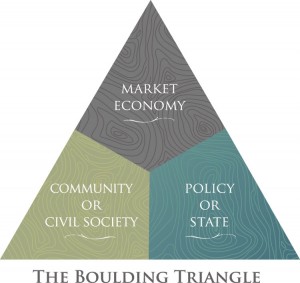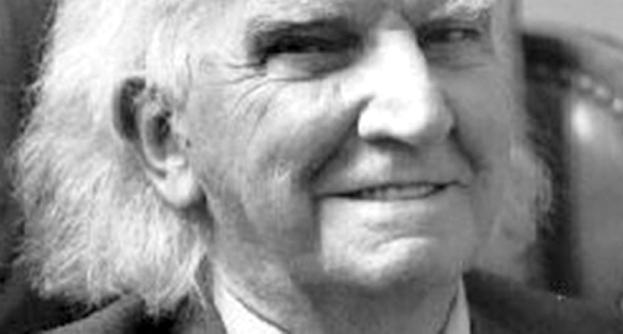Kenneth Ewart Boulding (1910 –1993) was an economist, educator, poet, religious mystic, devoted Quaker, systems scientist and interdisciplinary philosopher. He was nominated several times for Nobel Prizes in both peace and economics.
Boulding was born in Liverpool, England and taught in the United States at the University of Michigan for seventeen years and later at the University of Colorado at Boulder. He was co-founder of General Systems Theory and founder of numerous ongoing intellectual projects in economics and social science.
His approach to understanding the world focused on its interconnectedness, how things relate to other things. He wrote too about the place of philanthropic activity in society. One of his less well known contributions to the world of organizations and institutions is called, I believe, the Boulding Triangle. It is helpful in thinking the relationship between civil society, the economy and the state and the features of organizations that inhabit each sphere. It is depicted below.
 Boulding proposed a simple conceptual scheme to map out this terrain of which the above is an example. The triangle contains three ensembles of organizations and institutions dominated more or less by different organizational mechanisms: quid pro quo exchange in the market economy, coercion and redistribution in the polity or state, and gift, solidarity or reciprocity in the community or civil society quadrant.
Boulding proposed a simple conceptual scheme to map out this terrain of which the above is an example. The triangle contains three ensembles of organizations and institutions dominated more or less by different organizational mechanisms: quid pro quo exchange in the market economy, coercion and redistribution in the polity or state, and gift, solidarity or reciprocity in the community or civil society quadrant.
What is particularly interesting about the diagram is that each of these mechanisms in its purest form is located at one of the apexes; all the inner territory represents organizations and institutions embodying different mixes of mechanisms. In other words, in the middle organizations in one sector begin to take on the characteristics of the other sectors. They become hybrids of a sort.
Where would Professor Boulding, if he were still with us, place the Occupy Wall Street movement in the diagram? Would non-profit social enterprises and cooperatives fit more in the middle of the diagram? Would all legally incorporated non-profits comfortably reside in the civil society third of the triangle?
The Boulding Triangle is a reminder to be careful not to lump all non-profit organizations together as if they were a distinctive and separate sector. I hope, in future posts, to focus on some of the differences among non-profits organizations in terms of their key mechanisms, some sector outliers perhaps. Thanks Kenneth!
This image of the Boulding Triangle is the property of Governing Good, It should not be used without permission.




Very interesting way to position organizations, and how the voluntary sector could be viewed as component groups that are closer to or further away from the apex. How can government learn more about connecting with all these various parts, not just the ones that are leaders?